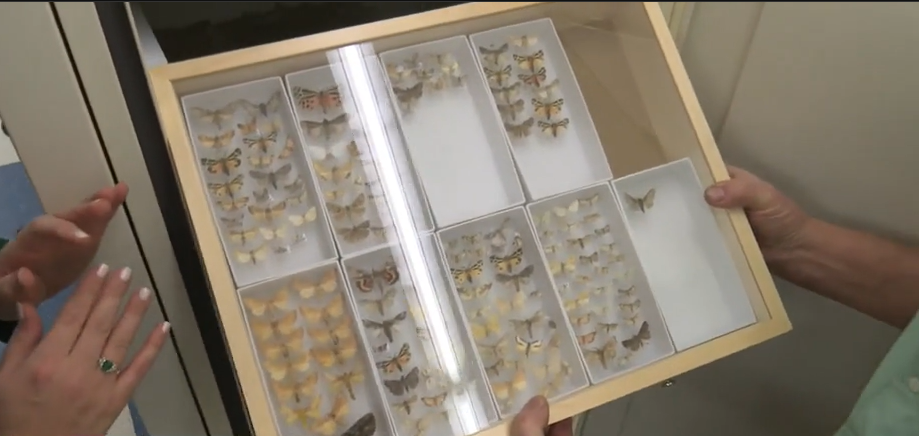Secrets of the Field Museum; the collection hidden behind closed doors

Some of the butterflies in the collection at the Field Museum of Natural History are 125 to 150 years old.
Click here for updates on this story
CHICAGO, Illinois (WBBM) — You’ve heard of lions and tigers and bears, but what about bugs and bones and snakes?
CBS News Chicago’s Marie Saavedra was very brave, taking a tour of the collections visitors don’t normally see at the Field Museum of Natural History, getting a behind-the-scenes look at things that are a little bit creepy, but can be very beautiful.
The museum’s arthropod collections include approximately 5 million pinned insects and other bugs, according to Jim Louderman, a collections assistant in the Field’s insect division.
The dearly deceased moths, beetles, butterflies and more tell stories, aid researchers, help the planet.
“We can collect things today in the same places they were collected 50 or 100 years ago to see what differences there are in the insect populations and species diversity,” Louderman said.
Some of the butterflies in the collection are 125 to 150 years old.
The museum also has two beetles collected by naturalist Charles Darwin, along with some of the heaviest beetles in the world, weighing up to 4 ounces – or ¼ pound.
“They’re good to eat. They have more protein than an 8- to 10-ounce steak. They have no fat or cholesterol,” Louderman said. “When you cook them, the insides congeal to a texture that’s identical to lobster.”
The cutest bug in the collection might be Rosie, a pink-toed and very docile tarantula with a bit of wanderlust.
“She has gotten away and wandered around the museum for three months one time. I should probably put the top back on,” Louderman said.
Meantime, the museum’s collection of amphibians and reptiles is one of the six largest herpetological collections in the U.S., with over 300,000 specimens.
Sara Ruane, curator of herpetology at the Field Museum, is a walking encyclopedia of all things reptilian.
Her favorite snake is a spider-tailed horned viper, with an appendage on its tail that looks like a spider.
“Birds think, oh there’s something to eat right there,” she said. “They fly on in, and they try to grab it and eat it, and the snake whips around and bites them and eats them instead.”
Saavedra had to remember the snakes in the museum are “no longer with us,” spending the afterlife cozied up in jars.
Even so, an amber-eyed boomslang at the museum looks almost alive.
“One thing about these specimens is, once they’re preserved, they can last hundreds of years and be used by scientists now and very, very far in the future,” Ruane said.
Like other exhibits at the museum, their collection of fossil vertebrates features holotypes – specimens that provide reference points for scientists.
“It’s kind of like a dinosaur warehouse,” said fossil vertebrate collections manager Bill Simpson.
Among other things, Simpson is an expert on the museum’s famous Tyrannosaurus Rex fossil “Sue,” who has more bones than you can see on display. Some of the extras are housed in drawers at the museum. They’re what’s known as float, a piece of fossilized bone that has eroded out of surrounding rock, leaving it essentially “floating” on the surface of the ground until it’s discovered by paleontologists, leading them to the rest of a fossilized skeleton.
Reproductions of Sue’s bones are used for research.
“We spent $85,000 on silicone rubber to mold every bone in Sue’s body, and then we made epoxy casts,” Simpson said – including a cast of Sue’s skull. “The actual skull is hard to study 13 feet up in the air.”
If you think Simpson has the best job in the world, he’ll agree. In fact, all of the museum’s guides said they couldn’t love their work more.
The next time you’re wandering the Field Museum, remember that visitors only see less than 1% of everything in their collections.
The Field Museum is renowned the world over. Its collections also are lending libraries that send materials to scientists across the globe.
If you live in Illinois, you can visit the museum for free on Wednesdays. You just need to provide proof of residency. For more information, log onto fieldmuseum.org.
We’re always looking for the stories that tell the tale of Chicago — its interests, its passions, the people who make this the city millions know and love.
Do you know someone a person or place that brings you joy? We want to share your story.
Please note: This content carries a strict local market embargo. If you share the same market as the contributor of this article, you may not use it on any platform.